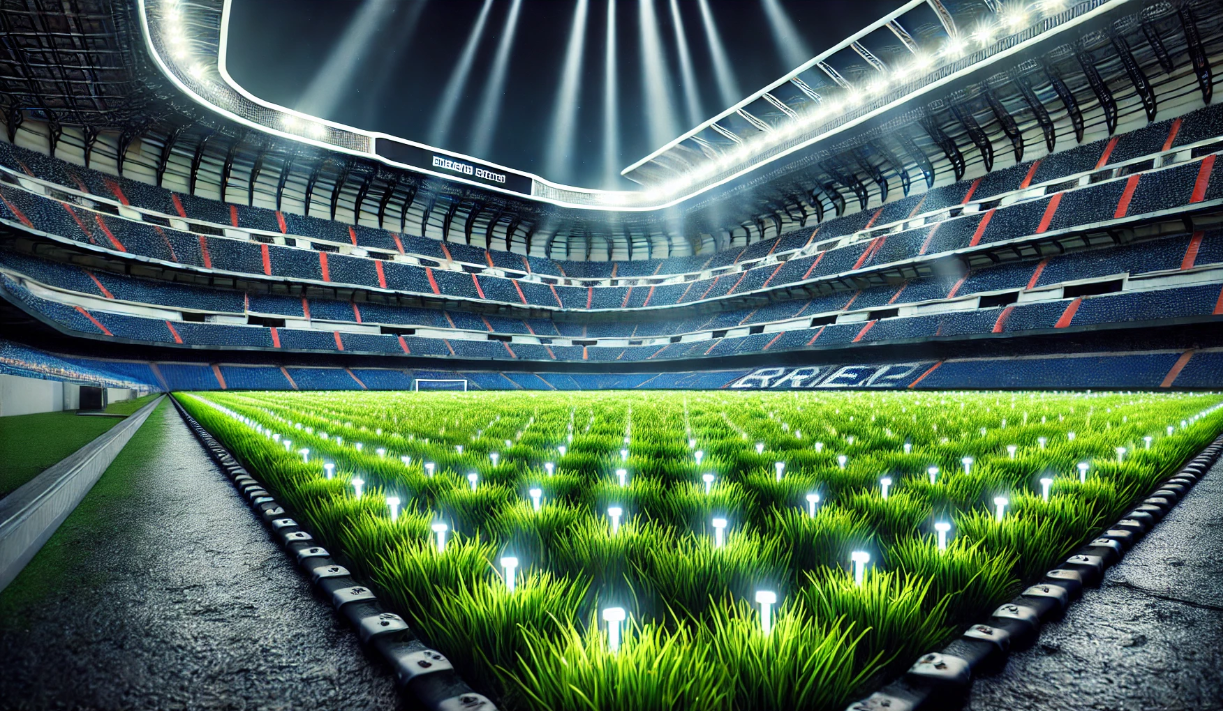Football turf plays a crucial role in ensuring high-quality playing conditions. Maintaining lush, durable, and healthy turf is essential for both aesthetics and performance. One of the key factors influencing grass growth is light exposure. Since natural sunlight is not always sufficient, especially in shaded or indoor stadiums, LED grow lights have emerged as a revolutionary solution. This article explores the importance of LED grow lights in football turf maintenance, highlighting their advantages, the effects of light spectrum, best practices for implementation, and how climate can impact grass growth.
Historically, stadiums relied on natural sunlight and conventional lighting systems to support grass growth. However, these methods have several drawbacks:
Inconsistent Light Distribution: Natural light varies due to weather conditions, seasonal changes, and stadium architecture, creating uneven turf growth.
High Energy Consumption: Traditional metal halide or high-pressure sodium (HPS) lamps consume more energy and generate excessive heat, leading to higher maintenance costs and potential turf damage.
Limited Control Over Light Spectrum: Unlike LEDs, conventional lighting lacks customizable spectra that cater to different growth stages of turfgrass.
LED grow lights offer significant benefits over traditional lighting, making them the preferred choice for maintaining football turf.
Energy Efficiency: LED lights consume significantly less power while providing optimal light intensity.
Customizable Light Spectrum: Different wavelengths can be adjusted to enhance turf growth at various stages.
Low Heat Emission: LED lights emit minimal heat, reducing the risk of turf dehydration or damage.
Longevity & Durability: LEDs have a longer lifespan, reducing replacement costs and maintenance frequency.
The color ratio of LED lights is crucial for promoting healthy and resilient football turf. Different light wavelengths influence photosynthesis, root development, and overall turf quality.
Blue Light (400-500nm): Enhances photosynthesis efficiency, improving turf density and vibrancy. It encourages leaf growth, making the grass thicker and more resilient to foot traffic. Ideal for the early growth stages to promote strong blade and root formation.
Red Light (600-700nm): Boosts photosynthetic activity, accelerating turf growth and recovery after damage. It improves stress tolerance, helping turf withstand harsh conditions and frequent play. Red light encourages root development, providing a strong foundation for stable grass coverage.
Far-Red Light (700-800nm): Regulates growth cycles, optimizing turf length and thickness. It enhances shade tolerance, benefiting stadiums with uneven light exposure. Far-red light also aids in cell elongation, making turfgrass more flexible and durable.
Green Light (500-600nm): Penetrates deeper into the leaf structure, balancing overall light absorption. It improves visual appearance, enhancing the turf’s natural green color.
UV Light (<400nm): Increases disease resistance, reducing the risk of fungal infections and turf diseases. UV light also helps control pests, minimizing the impact of insects that feed on grass.
Different climates have a significant impact on the growth and health of football turf. Turfgrass grows best in temperate climates, but maintaining optimal conditions can be challenging due to the variations in temperature, humidity, and sunlight.
Cold Climates: In colder regions, natural sunlight may be insufficient during winter months. LED grow lights can supplement natural light to ensure continuous turf growth, even in the offseason. These lights help maintain turf resilience to freezing conditions and frost damage, promoting turf recovery during spring.
Hot Climates: Excessive heat can cause turf dehydration and stress, especially in regions with high summer temperatures. LED grow lights with low heat emissions can help alleviate the risk of heat stress, providing light without overheating the turf. Additionally, the proper balance of light spectrum can encourage deeper root growth, helping the turf to withstand drought and high temperatures.
Humid Climates: Humidity can encourage fungal growth and turf diseases, especially in areas with frequent rainfall. The UV light spectrum from LEDs can help reduce the risk of disease by strengthening the turf’s natural defenses, making it more resistant to pathogens and pests.
Several football clubs and stadiums have successfully implemented LED grow lights to maintain optimal turf conditions:
Case Study 1: Guangzhou R&F Football Stadium, China
The Guangzhou R&F football stadium installed high-power 600W LED grow lights to supplement natural sunlight. The project resulted in healthier, denser grass with improved resistance to foot traffic and weather fluctuations.
Case Study 2: Crewe Alexandra Football Club, UK
Crewe Alexandra Football Club utilized LED grow lights previously used for indoor farming. The system significantly improved the stadium’s turf quality, allowing year-round play with minimal downtime for turf recovery.
To maximize the benefits of LED grow lights, football stadiums should follow these best practices:
Choose the Right Light Spectrum
A well-balanced LED light system should include:
Optimize Light Placement and Coverage
Distribute lights evenly to prevent patches of overgrowth or undergrowth. Adjust light intensity and duration based on the stadium’s natural light exposure.
Implement a Smart Lighting Schedule
Use LED lights during low-sunlight periods (e.g., winter months, nighttime games, or shaded areas). Adjust light cycles to match the grass’s natural growth rhythm.
Regularly Monitor and Adjust Light Settings
Conduct periodic turf health assessments to track growth progress. Modify LED intensity and spectrum based on turf condition and seasonal changes.

LED grow lights have revolutionized football turf management by offering a customizable, energy-efficient, and sustainable lighting solution. By understanding the importance of different light spectra, the role of climate, and implementing best practices, stadiums can ensure high-quality, durable, and visually appealing turf all year round. As more football clubs adopt LED technology, the future of sports turf maintenance is set to become more efficient, cost-effective, and environmentally friendly.
Get in touch for free lighting customization